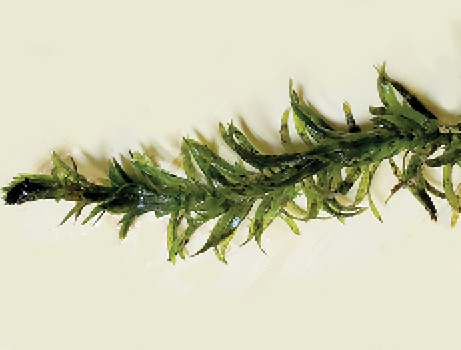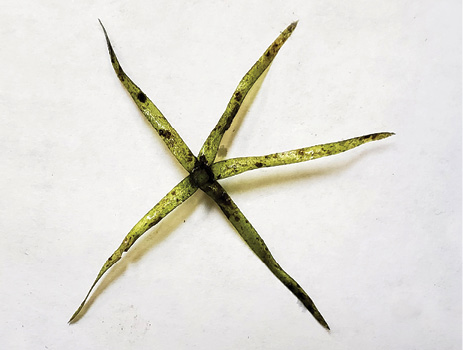Brazilian Egeria | Egeria densa
Submersed | Non-Native



and Elodea canadensis.
Brazilian egeria, or Brazilian elodea, is an invasive species to North America. Like native elodea, it is soft to the touch, with medium to dark green leaves that are flexible and narrow at the tips. The edges are finely serrated, but a magnifying glass may be necessary to see serrations. Leaves grow in whorls of three to six around the stem and are noticeably more crowded near the water surface.
This species is easily confused with two other species: Canadian elodea (Elodea canadensis) and hydrilla (Hydrilla verticillata). Elodea has three leaves per whorl and is smooth when pulled through the hand (no midrib teeth), while hydrilla has four to eight leaves per whorl and one or more teeth along each midrib, making it feel rough when pulled through the hand. Hydrilla has tiny flowers, egeria has larger flowers, and elodea flowers are intermediate.
The plant roots in muddy bottom sediments and sends stems toward the surface. Stems can be very long in clear water. Growth is submersed, but plants can top out on the surface and form mats.
Plants reproduce sexually by flowering or vegetatively by fragmentation. A single fragment can quickly expand asexually to fill a pond. Floating fragments can grow vigorously without rooting.
Management Value
Egeria is an invasive species. There is no known wildlife value for this species. Although this species can provide habitat for some aquatic species, it will quickly become abundant and should be eradicated on first detection.
Recommended Controls
Option 1: Triploid Grass Carp. Stock 5 to 10 grass carp per acre to reduce moderate egeria infestations; stock 15 or more per acre for severe infestations. Note that abundant grass carp can impact other fish and can survive 20 years.
Stock 8- to 10-inch triploid grass carp in ponds that have established largemouth bass populations.
Option 2: Chelated copper. Apply a liquid chelated copper (0.8-pound formulation) at a rate of 1.5 gallons per acre-foot. Determine pond volume prior to application. Copper can be toxic to fish when water alkalinity is low. Do not use copper in catfish or koi ponds when alkalinity is less than 50 ppm. Do not exceed annual herbicide rate limits as stated on the product label.
Option 3: Diquat (3.73-pound formulation). Diquat (0.5 gallon per acre-foot of water) should be applied as a submersed injection (subsurface application using a wand or hose). Determine pond volume prior to application. Do not exceed annual herbicide rate limits as stated on the product label.
Option 4: Endothall (4.23-pound formulation). Endothall should be applied as a submersed injection (3.2 gallons per acre-foot of water). Determine pond volume prior to application. Do not exceed annual herbicide rate limits as stated on the product label.
Option 5: Fluridone (4.0-pound formulation). Fluridone should be applied as a submersed injection (5.1 ounces per acre-foot of water); reapply at the same rate 30 days after initial treatment. Determine pond volume prior to application. Do not exceed annual herbicide rate limits as stated on the product label.
NOTE: Acre-foot = average depth of pond multiplied by pond acreage; average depth is calculated by taking the depth at 20 points across a water body and averaging the values.
Treat ponds when the plants are actively growing and the water temperature is at least 60˚F. It would be best to treat one-third of the pond at a time for larger water bodies, with 2 weeks or more separating applications. After the entire pond has been treated, a repeat whole-pond application may be necessary to eliminate remaining plants.
Read and follow all chemical label instructions, especially the section on the use of personal protection equipment.

The information given here is for educational purposes only. References to commercial products, trade names, or suppliers are made with the understanding that no endorsement is implied and that no discrimination against other products or suppliers is intended.
Publication 3735-5 (POD-11-23)
By Wes Neal, PhD, Extension/Research Professor, Wildlife, Fisheries, and Aquaculture; Dennis Riecke, Fisheries Coordinator, Mississippi Department of Wildlife, Fisheries, and Parks; and Gray Turnage, PhD, Assistant Research/Extension Professor, GeoSystems Research Institute.
The Mississippi State University Extension Service is working to ensure all web content is accessible to all users. If you need assistance accessing any of our content, please email the webteam or call 662-325-2262.


